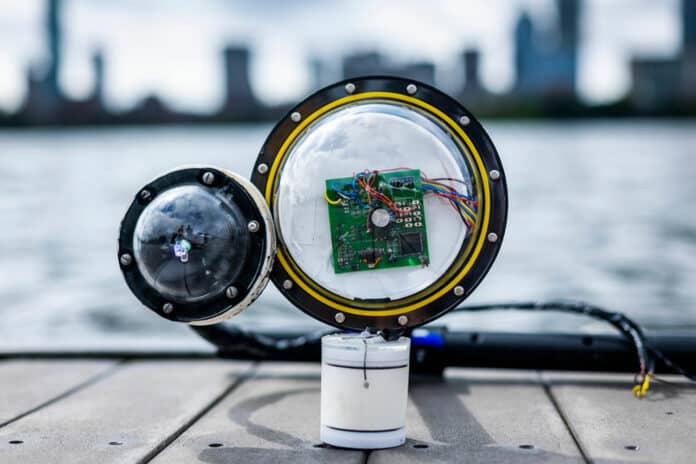More than 95 percent of Earth’s oceans have never been observed. MIT scientists have built a battery-free, wireless underwater camera to explore unknown ocean regions. The camera is about 100,000 times more energy-efficient than other undersea cameras and can capture color photos even in dark underwater environments, and transmits image data wirelessly through the water.
Sound provides the camera’s power. It transforms mechanical energy from sound waves moving through water into electrical energy to power its image and communications technology. The camera employs sound waves to convey data to a receiver that reconstructs the image after the image has been captured and encoded.
The camera can run for weeks before retrieval, allowing scientists to examine isolated ocean areas for new species. It can also uncover how much ocean pollution is there and monitor the health and growth of fish raised on aquaculture farms.
Fadel Adib, associate professor in the Department of Electrical Engineering and Computer Science and director of the Signal Kinetics group in the MIT Media Lab, and senior author of a new paper on the system, said, “One of the most exciting applications of this camera for me personally is in the context of climate monitoring. We are building climate models, but we are missing data from over 95 percent of the ocean. This technology could help us build more accurate climate models and better understand how climate change impacts the underwater world.”
Transducers composed of piezoelectric materials are positioned all over the camera’s exterior to collect energy. An electric signal is generated when a mechanical force is applied to piezoelectric materials. The transducers vibrate and change the mechanical energy of a sound wave passing through the water into electrical energy when it strikes them.
Those sound waves could come from any source, like a passing ship or marine life. The camera stores harvested energy until it has built enough to power the electronics that take photos and communicate data.
Ultra-low-power imaging sensors in the camera keep the power consumption as low as possible. But these sensors only capture grayscale images. And since most underwater environments lack a light source, they also needed to develop a low-power flash.
Adib said, “We were trying to minimize the hardware as much as possible, which creates new constraints on building the system, sending information, and performing image reconstruction. It took a lot of creativity to figure out how to do this.”
This problem has been solved using red, green, and blue LEDs. When the camera captures an image, it shines a red LED and then uses image sensors to take the photo. It repeats the same process with green and blue LEDs.
Research assistant Waleed Akbar said, “Even though the image looks black and white, the red, green, and blue colored light is reflected in the white part of each photo. When the image data are combined in post-processing, the color image can be reconstructed.”
“When we were kids in art class, we were taught that we could make all colors using three basic colors. The same rules follow for color images we see on our computers. To construct color images, we need red, green, and blue — these three channels.”
Using a technique known as underwater backscatter, image data are encoded as bits (1s and 0s) and delivered to a receiver one bit at a time after being acquired. The camera serves as a mirror to reflect the sound waves transmitted by the receiver through the water. The camera either sends a wave back to the receiver by reflecting it or transforms its mirror into an absorber to prevent reflection.
A hydrophone next to the transmitter senses if a signal is reflected from the camera. If it receives a signal, that is a bit-1, and if there is no signal, that is a bit-0. The system uses this binary information to reconstruct and post-process the image.
Afzal said, “This whole process since it just requires a single switch to convert the device from a non-reflective state to a reflective state, consumes five orders of magnitude less power than typical underwater communications systems.”
Scientists tested the camera in several underwater environments. In one, they captured color images of plastic bottles floating in a New Hampshire pond. They also took such high-quality photos of an African starfish that tiny tubercles along its arms were visible.
The device was also effective at repeatedly imaging the underwater plant Aponogeton ulvaceus in a dark environment for over a week to monitor its growth.
Scientists are now seeking to extend the camera’s range. They successfully transmitted data 40 meters from the receiver, but pushing that range wider would enable the camera to be used in more underwater settings.
Haitham Al-Hassanieh, an assistant professor of electrical and computer engineering at the University of Illinois Urbana-Champaign, who was not involved with this research, said, “This will open up great opportunities for research both in low-power IoT devices as well as underwater monitoring and research.”
Journal Reference:
- Afzal, S.S., Akbar, W., Rodriguez, O. et al. Battery-free wireless imaging of underwater environments. Nat Commun 13, 5546 (2022). DOI: 10.1038/s41467-022-33223-x
